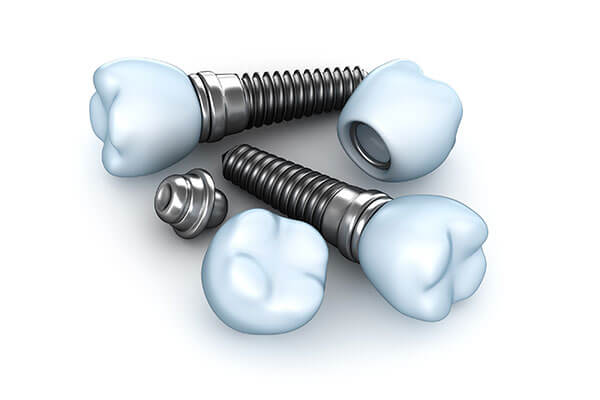Oral Surgery Procedures
Dental Implants

Dental implants are used to replace tooth roots. Implants provide a strong foundation for fixed or removable replacement teeth. Dental implants are small anchors made of biocompatible metal, called titanium, placed in the jawbone. The anchors begin to fuse with the bone over a few months. After the fusing process, known as osseointegration, abutment posts are inserted into the anchors to allow for the attachment of the replacement teeth. To fabricate the replacement teeth, an impression is taken and a model of the bite is created. The replacement teeth are based on this model. Replacement teeth can either be crowns, bridges or dentures.
Wisdom Tooth Removal (3rd Molars)

A wisdom tooth that is deemed problematic is normally extracted to avoid any oral complications. To have a wisdom tooth removed, a small incision is made to open up the gum tissue over the tooth and remove any bone that is covering the tooth. Once the tooth is in view, it is grasped with a dental instrument, known as a forcep, and gently rocked back and forth to loosen it from the jaw bone and surrounding ligaments. Sometimes the tooth may need to be cut into smaller pieces to make it easier for removal. Stitches may be necessary after the removal of a wisdom tooth.
Impacted Tooth & Tooth Exposure

An impacted tooth is a tooth that fails to fully pass through the gums.
Impacted wisdom and cuspid (or canine) teeth are fairly common. To correct impacted teeth, there are a few treatment options. For impacted wisdom teeth, the most common procedure is extraction. For impacted canine teeth, several treatment modalities are available. Orthodontics (braces) can be used to open space for proper eruption. Primary (baby) teeth can either be extracted or surgically exposed to allow for the placement of an orthodontic bracket to help align the teeth.
Bone Grafting

Bone grafting is the replacement or enhancement of bone around teeth. When a tooth is lost, the surrounding bone collapses. Bone grafting is performed to reverse bone loss or enhance existing bone. The grafting material can be taken from parts of the body or from synthetic material. Bone grafting allows for proper support of dental implants or prostheses.
Tissue Grafting

Soft Tissue Grafting is commonly used to treat root exposure resulting from receded gum tissue. Tissue is removed from the roof of the mouth or from gum tissue near the tooth and stitched into the area needing gingival repair.
Gum Shaping

Gum reshaping or contouring is a procedure performed to reshape the gums if they rest too low or too high on your teeth. In order to reshape the gum tissue, a line is drawn to mark the new gum line. Once approved, anesthesia is applied to the area and the contouring begins. A dental instrument (typically a scalpel or laser) is used to reshape the gum tissue and trim away any extra tissue overhanging the tooth.
Labial or Lingual Frenectomies

A frenectomy is a simple surgical procedure performed to release the connection of the “frenum,” a connective muscle between two tissues. There are two types of oral frenectomies that are frequently performed on both adults and children for a variety of reasons.
A Labial Frenectomy is performed on the tissue that connects the lip to the gums. This may be performed on children or adults to aid with orthodontic treatment or even help with the proper fitting for a denture or appliance.
A Lingual Frenectomy may also be referred to as the release of tongue-ties (ankyloglossia). This procedure is performed on the connective tissue under the tongue. The procedure is often performed on neonatal patients to assist with nursing or on toddlers or older patients who need the surgery to help correct speech issues caused by limited movement due the the frenum.
Ridge Preservation

Adequate bone volume of the jawbone is necessary for the secure placement, stability, function, aesthetics and longevity of implants. Because tooth loss can result in diminished bone volume in the jawbone, a bone expansion procedure may be necessary prior to implant placement. This procedure can increase the height and/or width of the jaw ridge through the use of mechanical manipulation combined with a bone graft. The Ridge Expansion takes several months to mature and be sufficiently strong for the placement of implants. Ridge Expansion not only improves the function of implants, but is also a key contributor to the enhanced aesthetics, filling in the face around the gums and jaw and thus minimizing the appearance of aging.
Extractions

A tooth that can not be saved with restorative materials may need to be removed. First, the area will be numbed with anesthesia. The tooth is then loosened with a special dental instrument known as an elevator. After the tooth is loosened from the socket, it is removed. Stitches may be necessary after the removal of a tooth.
860-783-5820
Call our office today!
Location
21 Buckland Street
Manchester, CT 06042
Click for Directions
